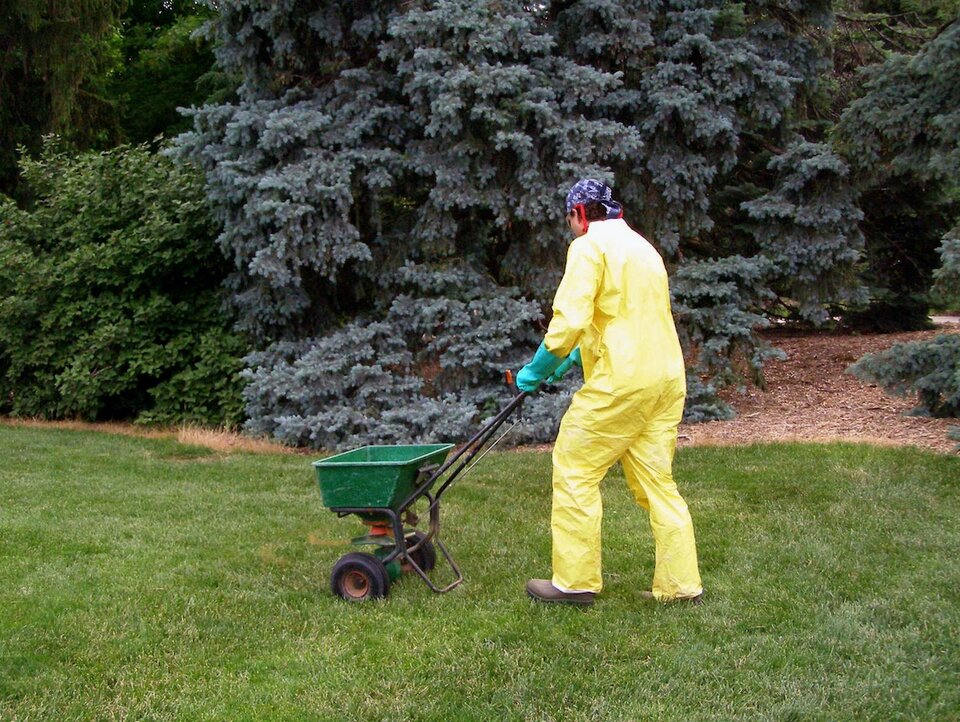Using Pesticides Correctly

We are getting closer to fall which is a great time to work on improving your lawn. Late September and early October are great for spraying lawn weeds. When dealing with pests in your lawn, be sure to use pesticides correctly for the best success and for the least amount of damage to the environment.
Photo from the UNL Pesticide Safety Education Department
Pesticides
Pesticide is the general term for any insecticide, herbicide, fungicide, etc. Insecticides are specific to insects, herbicides are specific to weeds, and fungicides are specific to fungi. The first step in using pesticides is to correctly identify the pest you are dealing with to ensure you are using the correct chemical for the pest. Then determine all the methods that can be used to control the pest and use the best choice.
Timing
Timing of pesticide applications is critical. For example, fungicides should be applied as a preventative on fungi before they show up. Once you begin to see a fungus on your plants, in many cases, it may already be too late to fix the damage with a fungicide.
When discussing weeds, the type of weed and its growing cycle makes a difference on when and how to manage it. Winter annuals such as henbit become a problem for us in the spring, but they are best controlled in the fall with a pre-emergence herbicide or in the later fall with a post-emergence herbicide.
Summer annuals such as crabgrass should be controlled in the early spring with a pre-emergence herbicide. Treating crabgrass in the late summer, such as August, is not effective. In the late summer these plants are very large and difficult to control. Also, they only have a few more weeks left in their life before they die from frost. The new plants next spring are those that germinate from seed, not from those plants you see today.
Perennial weeds come back every year and often flower in the spring or through the summer, but they are best controlled in the fall with post-emergence herbicides. In the fall plants are moving nutrients into the roots for winter storage, they will more readily take herbicides with them to work better.
As for insecticides, it is much easier to kill a young, early-stage larvae, rather than a full-sized beetle or even a large, late-stage larvae. For example, insects such as white grubs should be controlled with granular insecticides applied to the lawn as the eggs are being laid so that the first stage out of the egg feeds on the granules.
Application Methods
Always read and follow the label because the label is the law. Also, be sure to wear the correct Personal Protective Equipment or PPE such as gloves, long pants, long-sleeved shirt, and eye protection that is listed on the label when applying pesticides. Apply pesticides at the label recommended rates. Pesticides applied at incorrect rates can cause resistance to occur making the pesticide ineffective. Using more product than what is listed on the label can actually reduce the effectiveness and can cause the top of the sprayed weed to just burn back rather than kill the roots. This will leave a brown spot in the lawn where it was sprayed rather than kill the whole plant and allow grasses to grow in around it as it dies.
When using pesticides pay close attention to the weather. Do not apply pesticides on windy days, as the spray droplets are easily picked up in the wind and blown to non-target plants. Certain chemicals, such as 2,4-D and Dicamba can volatilize or turn into a gas to move to non-target plants to cause damage or death when the pesticide is applied when the temperature is above 80 degrees Fahrenheit for the following 72 hours.
Using Pesticide around Vegetables and Fruits
During gardening season, use caution when utilizing pesticides in the garden, remember food safety practices. Make sure that the pesticide is labeled to be used on the plant you plan to use it on. If that plant isn’t on the label, the pesticide cannot be used on it. Also, follow the PHI or Pre-Harvest Interval, which tells you how long to wait from application of the pesticide until harvest. And finally, follow the re-application interval to know how long to wait before applying the pesticide again.
This article was reviewed by John Fech